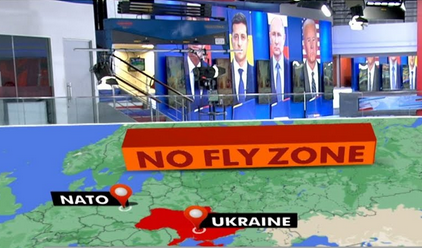Photos: YouTube
Last week, Reuters/Ipsos (3/4/22) reported on a poll that found some 74% of Americans―including solid majorities of Republicans and Democrats―said the United States and its allies in the North Atlantic Treaty Organization should impose a no-fly zone in Ukraine.
This was a surprising result, because there was strong bipartisan opposition in Congress to such an action. Typically, public opinion―especially on foreign policy―tends to reflect the prevailing political consensus.
That poll announcement was followed this week from a report from YouGov (3/9/22) about three polls it had recently conducted―two for the Economist (2/6/22–3/1/22 and 3/5–8/22), and one for US News (3/7–9/22). The earliest poll found 45% of Americans saying it was a “good idea” for the US to enforce a no-fly zone over Ukraine, with 20% saying it was a “bad idea.” The second poll showed a smaller margin of support, 40% to 30%.
In its third poll for US News, YouGov ran a split-sample experiment, with half the sample asking respondents if they would “support or oppose the US enforcing a no-fly zone over Ukraine,” and the other half asking the same question with the additional comment: “which would mean the US military would shoot down Russian military planes flying over Ukraine.” The purpose was to determine if an explanation of what a no-fly zone means would affect support.
Both questions elicited plurality support for the no-fly zone―42% to 28% when no explanation was provided, 42% to 33% when an explanation was provided. The explanation seemed to have little effect.
But when YouGov rephrased the no-fly question in terms of the action required, it got a markedly different response. The second Economist poll asked, “Should the US military shoot down Russian military planes flying over Ukraine?” A 46% plurality said no—16 percentage points more than said a no-fly zone was a bad idea.
And as the report indicated, large segments of the respondents gave self-contradictory answers:
Nearly three in 10 of those who say that enforcing a no-fly zone is a good idea also say that they oppose the US shooting down Russian military planes flying over Ukraine; 13% of those who call enforcing a no-fly zone a bad idea support the US shooting down Russian planes.
Making sense of polls
The Reuters poll can be dismissed as a representation of actual public opinion. Typically, Reuters/Ipsos does not measure, or ignores, “don’t know” or “unsure” responses. As I noted in a previous post (FAIR.org, 2/11/22), using that “forced-choice” format creates the illusion of public opinion, but does not give a plausible picture of reality.
The YouGov polls, by contrast, all included measures of “no opinion.” The poll for US News also included a measure of intensity, which provides even more insight into what the public is thinking.
US News/YouGov Poll on US Enforcing a ‘No-Fly Zone’ in Ukraine
Typically, news media combine the “strong” and “somewhat” categories when reporting the results—as I did (42% to 28% in the first group; 42% to 33% in the second group). But that format suggests a more solidly opinionated public than is warranted.
For both groups, only just over a third of respondents felt “strongly” about their views (37% strongly support or oppose in the first group; 36% in the second group). The rest are either “unsure” or hold views that are loosely held (“somewhat” support or oppose).
The weakly held or “top of mind” views explain how many people can provide self-contradictory responses. They simply haven’t given the issue much thought. New questions elicit new opinions, some of which contradict previous responses.
Those weakly held views also explain why “public opinion” can seem to fluctuate so greatly, as new information comes to light.
The key conclusion here is that most Americans have not firmly decided about the merits of a US-enforced no-fly zone. That conclusion no doubt holds true for most, if not all, of the other policy proposals included in the poll.






